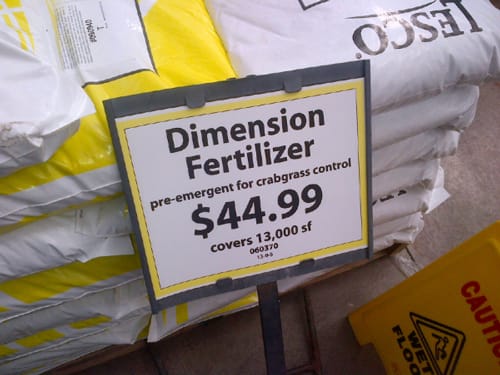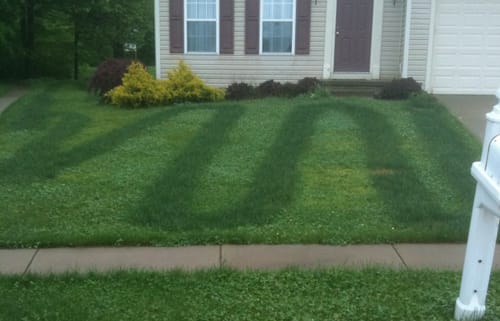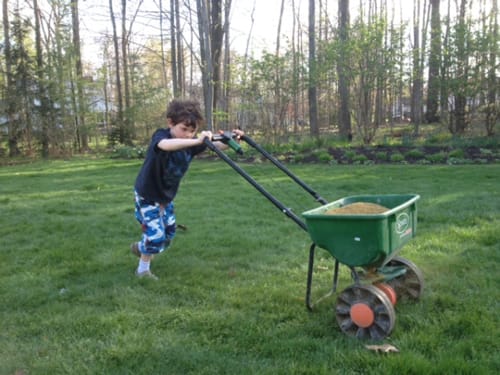Choosing a Spring Lawn Fertilizer
by Alec McClennan, on March 28, 2013
So the snow is melting and the birds are flying. The lawn isn't looking so hot and you're concerned about getting something on there to help get it going and prevent the much dreaded crabgrass from sprouting. What to do?
Below is a standard Pre Emergent Crabgrass Control and fertilizer. It covers 13,000 square feet for $45.

Problems Spreading Traditional Lawn Fertilizers
The fertilizer pictured above contains something called a "Pre-Emergent" which kills seeds before they can become plants and in doing so prevents annual weeds, like crabgrass from getting well established. In order to do this, the chemical forms a blanket over your lawn that lasts for about 2-4 months and kills weeds as they sprout. Sounds great, but who wants to be rolling around on a blanket of chemicals all summer?
Another issue with traditional fertilizers is that you're more likely to get "striping" like you see below, or burn spots.

Consider An Organic Fertilizer Alternative
This year, why not skip the chemical crabgrass pre-emergent fertilizer and consider fertilizing your lawn in the spring with a natural organic fertilizer that will feed the soil and the grass to help it fight off weeds on its own?
Corn Gluten Meal is an excellent lawn fertilizer and contains 9% slow release organic nitrogen. As an added bonus, some research has indicated that fertilizing your lawn with a corn gluten meal based fertilizer will result in a lawn that has fewer weeds and less crabgrass.
A typical Corn Gluten Meal Based Organic Lawn Fertilizer will typicaly cover about 1/3 of the area that a chemical fertilizer will cover. This is because organic fertilizers contain organic matter and are much less "nutrient dense" than their synthetic counterparts. The organic fertilizers don't actually contain any nutrients for the plants themselves, they feed the soil and the soil organisms convert the organic fertilizer into a substance the plants can use. This conversion process takes time, builds the health of your soil, and results in a nice slow release - just what the grass wants.
Good Nature's Earth Turf Spring Blend is a corn gluten meal based fertilizer. It sells for about $40 for a 50lb bag and will cover about 5,000 square feet. So, it's a little more expensive than your standard chemical fertilizer, but it's a small price to pay for the peace of mind that comes from knowing that your family is playing on a blanket of Corn Gluten Meal, rather than a blanket of chemical crabgras control.
How to Apply an Organic Lawn Fertilizer
Applying Good Nature's Earth Turf Spring Blend is so easy, a kid could do it! Back when I was a kid I used to apply chemical fertilizers at my parents home until we learned about the dangers associated with chemical lawn care products. Here's one of our clients son's spreading his organic fertilizer.

Applying an organic fertilizer is actually much easier than applying a chemical fertilizer because you don't have to be as precise or worry as much about burning the lawn with an over application.
Step 1 - Determining Your Lawn Size
The first step to fertilizing your lawn is to know it's square footage. This can be as simple as pacing off the dimensions (1 long step usually equals about 3 feet) and doing a little geometry. Or, you can visit www.findlotsize.com and see if you can't use the website's tools to measure your lawn area. If all of that is too much, give us a call at 888-529-6723 and we can use our software to help you calculate your lawn's size.
Step 2 - Setting your Spreader & Applying Fertilizer
With our Earth Turf Spring, you can pretty much set your spreader on the most open setting you have. If you're concerned that you'll be applying too much fertilizer, set it about half way open and cover the lawn once. Start by outlining the lawn and then make back and forth passes that are parallel to each other.
When you spread, you should space your tracks so that the fertilizer spreads all the way back to your last track. Chances are, after you finish the first pass, you'll still have fertilizer to spread. Go ahead and make another pass, this time make your tracks perpendicular to the first set. Continue this process until you've used the right amount of fertilizer for your lawn. Going over in multiple passes has a few benefits:
- A little exercise!
- You cover the ground more evenly than if you just do one pass
Drop Spreader vs. Broadcast Spreader
A Broadcast (whirlybird) spreader that flings the fertilizer out to the front and side of the spreader is probably the easiest way to fertilize your lawn. It gives you a little more margin for error than a drop spreader but also leads to fertilizer ending up in the beds and sidewalks etc. A little organic fertilizer in the beds is actually good for the plants in there so I wouldn't worry about that. I would recommend sweeping up the sidewalk and driveway though and leaving the fertilizer you are sweeping right along the edge of the lawn.
A Drop Spreader might be better for spreading grass seed or something you want to keep out of the beds, but for fertilizer it can be more work. The same principles apply though, just make sure to cover all areas of the lawn with the spreader. With a drop spreader it is even more important to make two perpendicular passes over the lawn.
Step 3 - Relax
It does not hurt to water in the earth turf spring and it can be beneficial, but it isn't required. You shouldn't worry because it won't burn your lawn like a standard fertilizer could. If you are going to water it in, we recommend giving it a good soaking (a few hours with the sprinkler) and then not watering again for at least a week. In general, the spring rains will keep you from having to water the lawn at all, but if you'd like to water, that's the way we'd recommend doing it.
Step 4 - Feel Good
Now you can walk barefoot in your lawn and not feel like you're walking on chemicals. Crack open a lemonade and watch the kids, pets, and wildlife enjoy the lawn.













